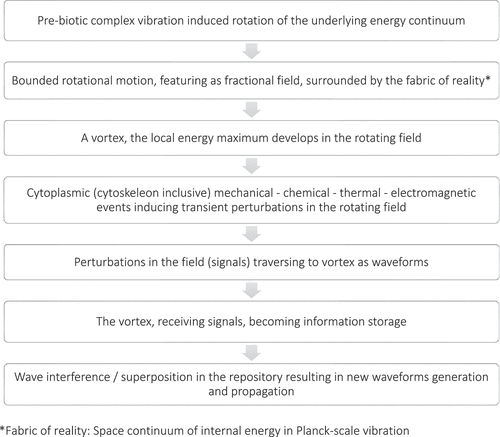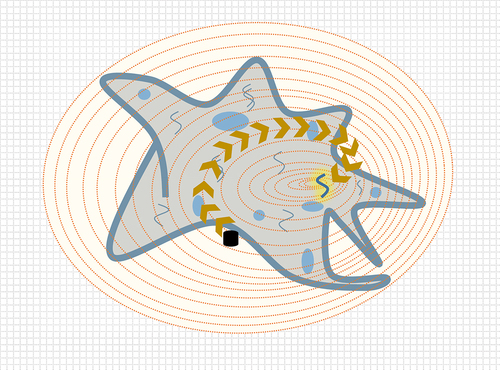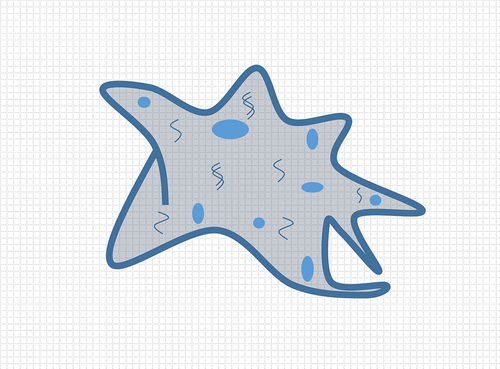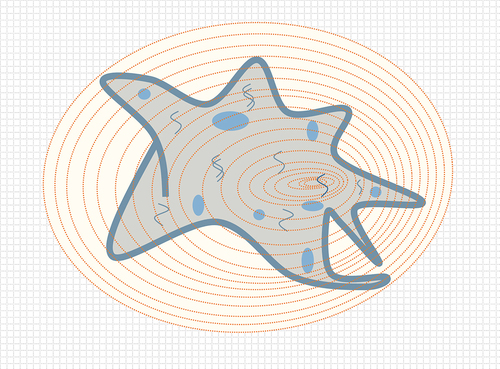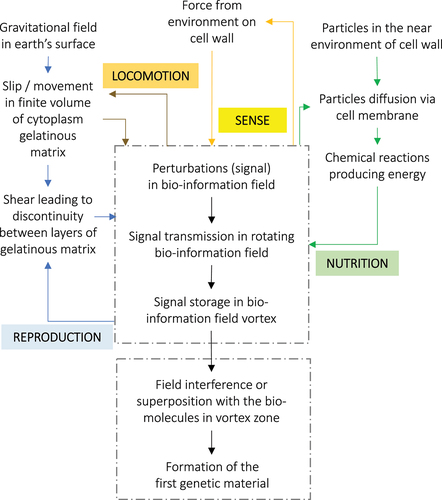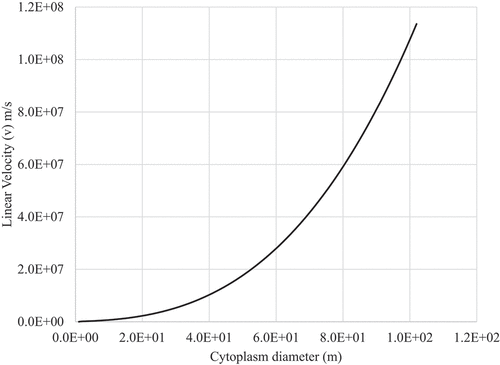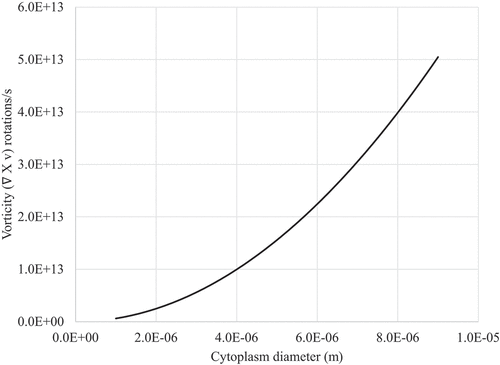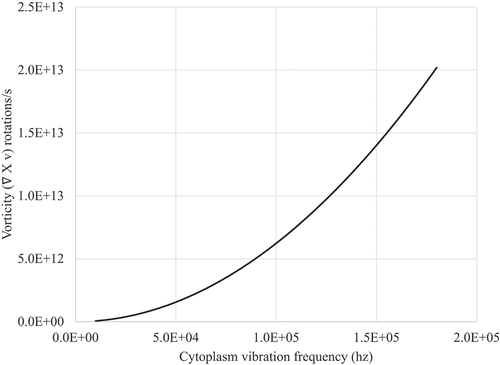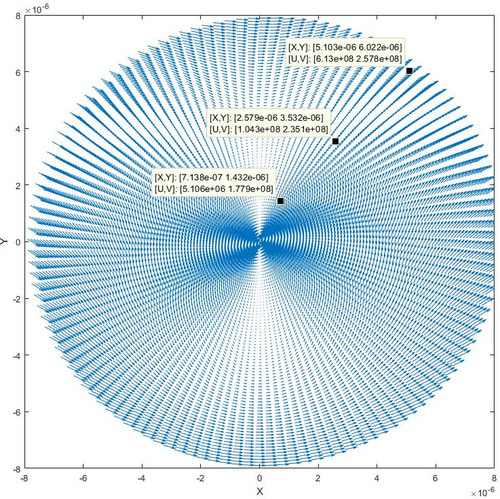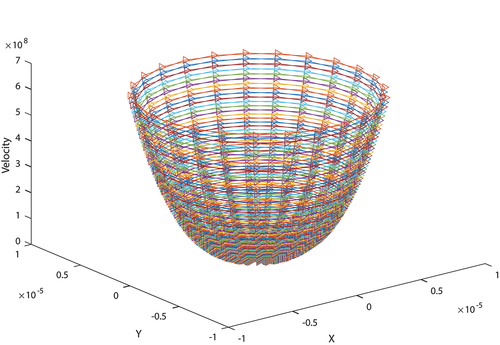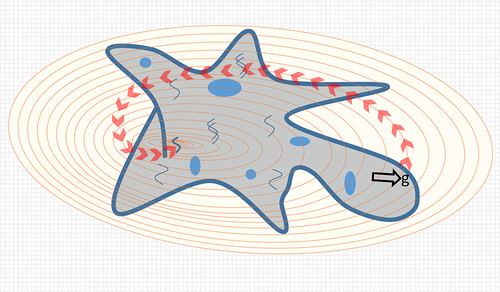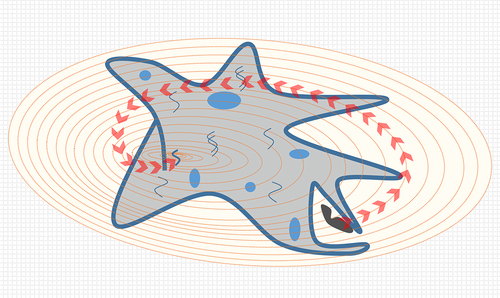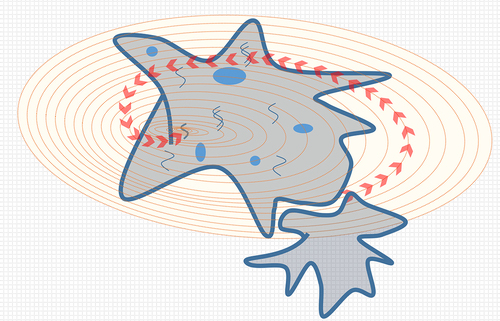 ?Mathematical formulae have been encoded as MathML and are displayed in this HTML version using MathJax in order to improve their display. Uncheck the box to turn MathJax off. This feature requires Javascript. Click on a formula to zoom.
?Mathematical formulae have been encoded as MathML and are displayed in this HTML version using MathJax in order to improve their display. Uncheck the box to turn MathJax off. This feature requires Javascript. Click on a formula to zoom.ABSTRACT
As every life form is composed of cells, elements of consciousness, namely memory and sentience, must be grounded in mechanisms that are integral to unicellular organisms. Earlier studies indicated that cellular cytoskeletal structures consisting of excitable, flexible, and oscillating polymers such as microtubules, along with quantum events, are potentially responsible for information processing and thus consciousness. This work attempts to solve the unknown, that is, how, at the spark of life, the phenomenon of cellular information processing first appears. This study posits that the spatially distributed wave energy of the molecules of an incepting cell interacts with space and generates a rotating bioinformation field, forming a vortex. This vortex, the local energy maximum, whose inbound and outbound energy fluxes represent signal reception and dispersal, is a critical step in the spark of life responsible for information storage, and with incremental wave superpositions, exhibits information processing. The vorticity of the rotating field is computed, and the obtained field characteristics indicated the emergence of a prebiotic complex to initiate information processing. Furthermore, the developed system model explains how perturbations from the environment are converted into response signals for the emanation of sense, locomotion, nutrition, and asexual reproduction, the fundamental evolutionary building blocks of prokaryotes. Further research directions include explaining how the energy potential available in the bio-information field and the vortex leads to the first formation of genetic material, emergence of cytoskeleton, and extension of bio-information field to multi-cellular organisms.
1. Introduction
Human existence is defined by consciousness. It enunciates cognition, awareness, experience, feeling, perception, and awareness of awareness or self-awareness. However, the basis or rationalization of consciousness remains unknown. Several schools of thought regarding its foundation were proposed by pioneers in the field. Among them, biophysics research in general identifies consciousness as an evolutionary sequel to the physical and biological processes of the human system or lower organisms and is manifested as a result of biological computations during the evolutionary process [Citation1–3].
Earlier views that consciousness belonged only to higher-level organisms reformed when experiments in unicellular organisms identified signs of memory and cognition. In one study, the paramecium was made to learn to associate a food-wire, demonstrating that at least a minor proportion of the physiological machinery that was essential for cognitive learning might be executed not only through the neuronal activity of a higher organism, but also by the individual cells themselves [Citation4]. Another study found that a prokaryotic organism entering a nutrient-rich environment attains an internal state of satisfaction and assumes locomotion; however, when an unfavorable environment is encountered, it reaches a negative subjective state exhibited with backward movement to the one that is remembered from memory [Citation4,Citation5].
Such studies led to an augmenting skepticism among scientific researchers including physiologists, ethologists, geneticists, and biologists that consciousness, cognition and the mental state or collectively, the ‘sentience’ is an intrinsic characteristic traced back to the origin of life. Although consciousness is a fundamental occurrence in all life forms [Citation6], how consciousness emerges in life forms remains a research question surrounded by speculative opinions and ideas with no convergence. Although numerous molecular and quantum events appear to be probable candidates for explaining the association between consciousness and the origin of life, the exact association remains elusive.
2. Relevant literature
2.1. Search for consciousness in cellular components
Evidence from literature suggests three possible cellular structures and concepts that are considered to play a crucial role in such events. They are structurally flexible proteins, excitable membranes, and vibrating cytoskeletal polymers such as microtubules.
Cellular membranes possess a key fundamental property to become excitable when stimulated by environmental signals [Citation7–9]. In addition, the lipid bilayers present in the cell membrane possess quasi-crystalline properties that are considered probable sources of cellular awareness [Citation10]. These excitable cellular membranes are not only present in eukaryotes but are also believed to have been present in early prokaryotic species [Citation11,Citation12].
Another probable source of sentience and memory is the presence of oscillating cytoskeletal polymers such as microtubules [Citation13,Citation14]. In addition, actin filaments are believed to act as excitable media and are also involved in transporting organelles and ionic waves [Citation15]. The oscillating cytoskeleton also bolsters highly ordered groups of excitable membranes, the lipid rafts, which possibly perform signal transduction [Citation16].
Finally, certain special and flexible proteins with quasicrystal properties and five-fold symmetry are believed to be responsible for the emergence of sentience. The flexible nature of these proteins suggests that they contribute to subjectivity within single cells. It has been suggested that these proteins utilize knowledge acquired over the entire evolutionary process to support the survival of living systems [Citation16].
Hence, it is speculated that either one or any of the combinations of the three potential structures discussed above is responsible for the emergence of cellular and subcellular sentience and memory.
2.2. Classical and quantum approaches to consciousness
The cell of an organism has been shown to oscillate and generate vibrations that flow throughout the cytoskeletal system and based on the resonance produced, theories have suggested formative causation in a developing organism. Accordingly, the resonating fields generated by developing organisms aid in shaping organisms. Several such fields interfere and associate together in the formation of multicellular organism [Citation17]. Thus, resonance, a phenomenon in which a vibrating system resonates with oscillations of another system at particular frequencies and eventually elicits a sequence of events that lead to energy transmissions, is considered a potential means for information processing. Along similar lines, Orch-OR theory [Citation18] proposed that microtubules with their strong oscillations act as signal amplifiers and filters, generating a conscious moment, which can be annulled at the collapse of the wave function in the space-time fabric of general relativity, thus connecting quantum level information processing with space-time.
Thermodynamic approaches to life propose the Seebeck-Peltier-like transition in cell membranes as the essential building block of how life works [Citation19], thereby connecting consciousness with the thermophysical exchanges of a cell. Akin to microtubules’ conductive resonant patterns [Citation20], at the cell-level, thermodynamic resonance linked to membrane heat flux variations is posited as a phenomenon for explaining cells as an adaptive thermal engine [Citation19].
Quantum consciousness, a body of hypotheses that evolved, brought in the view that classical mechanics alone cannot explain consciousness, and quantum-mechanical events, such as coherence, entanglement, and superposition, play a role in cell function. The notable ones related to the evolution of life were (1) Q-life-quantum replication of information, (2) DNA expression as a quantum database search, (3) DNA strands in quantum entanglement, and (4) Mutations via proton tunneling etc [Citation21,Citation22].
Further, the recent efforts to evince consciousness with super-fluid and Bose–Einstein condensate (BEC) matter, have opened new directions in research. In one pertinent research, the fabric of reality is supposed to have resonating quantum states related to quantum vacuum fluctuations of a super-fluidic quantum space (SQS) [Citation23]. Most of the biological matter, including brain is made of 70% or more water and there is a significant focus on explaining bio-physical events with water. In one example, biologically structured water is supposed to be capturing, storing, resonating, amplifying, and transmitting a wide spectrum of electro-magnetic energy [Citation24]. In another, brain is hypothesized to undergo symmetry breaking like in condensate matter reaching coherent states [Citation25,Citation26].
Although there are a handful of hypotheses connecting unicellular structural elements and consciousness via quantum and classical mechanics, scientific evidence-based consensus has not yet been reached. In addition, the relation to the prebiotic complex turning out as conscious life is not addressed by these hypotheses.
The consciousness literature also leverages systems theory, such as in the case of Integrated Information theory, attempting to explain how conscious states evolve because of past events and the present stimuli governed by certain laws of nature [Citation27]. Other views have proposed constructal law as self-standing in physics, covering the optimality of a bio-system in terms of entropy, energy flow, time, and physical forces [Citation28]. Even in approaches that deal with premises such as entropy and cause–effect repertoire, the journey of prebiotic complex to conscious life remains unexplained.
2.3. Origin of life, information processing and proto-consciousness
Regarding the series of events associated with the spark of life, the concept of consciousness remains elusive. The microfossils discovered in the banded iron rocks as early as 4.28 Gya are considered by researchers to be the evidence of early life on earth. The genomic approach to the bacteria and archaea branches, identified 355 common gene sets from 2,86,514 protein clusters, arriving at the last universal common ancestor (LUCA), the so far known best representative of early life characteristics. The prevailing view however is that the origin of life is far different from LUCA and is least understood [Citation29].
Abiogenesis, the process in nature by which life emerges from inanimate matter, is characterized by prebiotic synthesis of organic molecules, molecular self-replication, self-assembly, autocatalysis and emergence of cell membranes [Citation30]. The renowned Miller experiment demonstrated that the physical building blocks of abiogenesis can be synthesized abiotically leading to the prebiotic chemistry framework. Further suppositions include triggering of these reactions by external energy sources such as lightning, micro-meteors, radiation etc [Citation31].
The challenge with the prebiotic complex emergence is two-fold: (1) Necessity of all parts for the system to form independently (e.g. DNA and DNA polymeric enzymes that need each other to produce themselves). (2) Complex interlinking between the parts of the system to enable the functions witnessed in early life forms such as LUCA [Citation32]. It is obvious that the flow of matter and energy across the early molecular systems led to the development of more ordered states, enabling interlinking between the parts causing the emergence of the systemic functions witnessed. The complex interlinking must also have involved information flow between the parts [Citation33]. Thus, the inception of the first genetic imprints was made possible by the matter, energy and information flow across the molecular structures that were independently capable of self-replication, self-assembly and auto-catalysis.
Furthermore, the information encoded in a genome of any early life form such as LUCA, must have been acquired as a sensory signal in the cytoplasm or membrane. Genome is not known to be interacting directly with any external prompt or sensory signals acquisition does not have any direct involvement of the genome [Citation33]. Thus, a question of how a genome becomes a system-level memory arises.
By and large, the flow of energy-information as a necessary condition for emergence, is a juncture where theories that deal with bio-fields bring in an alternative but integrative perspective. The spectrum of hypotheses includes, (1) Underlying bio-field at coherent quantum level oscillation of molecules, (2) Bio-electro-magnetic fields of coherent resonances associated with cell membrane, (3). Bio-photonic communication fields with information presence [Citation34], (4) Pervasive information field, a summary envelope of all matter-energy interactions of a cell [Citation35] etc.
In a nutshell, hypothesizing a primitive chemical mixture as in prebiotic chemistry, to have the bio-system-level characteristics of LUCA, without an information processing means, certainly leads to gaps in theory building. Thus, the memory and sentience associated with the evolutionary steps of LUCA call for the investigation of information processing capability inception in the journey of prebiotic complex to LUCA. Bio-energy or in specific bio-information fields are an enabling theoretical means in this juncture.
Meanwhile, the information processing aspect during the evolutionary steps of LUCA brings memory and sentience (elementary stimuli-response) and thus traces of primitive consciousness into the picture. Research works based on the cognition signature in microbial fossils opine that primitive consciousness began around 3.7 billion years or more ago and is coincident with life [Citation36,Citation37]. The phenomenon of qualia, sentience, systemic memory etc, if purely dependent on biochemical processes, then their actual nature must be decipherable [Citation33]. The inability to deduce this emergence as a function of its simple bio-molecular basis, implies that certain fundamental elements are missing in the main-stream evolutionary biology. The emanation of bio-system-level proto-sentience, proto-memory, proto-consciousness, and its connection to abiogenesis is far from understood. Here again, bio-fields dealing with information management, electro-magnetic resonance, photonic information, quantum coherence etc, have not been investigated for their relevance to the steps between abiogenesis and LUCA.
The research questions that open in this juncture are, (1) How and when the first ever bio-field capable of information processing form in biological systems? (2) What mechanisms governed information registry, transmission, processing, and retrieval in such information fields? (3) How did the first forming information field establish memory and sentience? (4) What degrees of freedom such a proto-information-field possessed, so as to perform system-level information management? (5) How did the information management in the proto-information-field lead to basic system functions such as nutrition, locomotion, reproduction during the steps between the prebiotic complex and LUCA? and many more.
3. Hypothesis and system model
The background theories that this study leverages are highlighted to set the context for the proposed hypothesis.
Review works posit the bio-field as an encompassing descriptor for the electromagnetic, mechanical, photonic, and other types of spatially distributed energy fields generated by living systems and is able to encode information that governs organization and regulation at the bio-system level [Citation38]. Electromagnetic field theories of consciousness propose that the electromagnetic field generated by charge flow in cell processing enables information integration and processing [Citation39–41]. Similarly, chemical-physical processes and cell wall vibrations are found to produce the emission of mechanical waves of frequency bands up to 100 kHz [Citation42,Citation43], and these waves can be correlated with the information processing of the cell. One of the notable hypotheses in this area is the pervasive information field: Similar to Einstein’s space-time fabric of reality in gravity, this field constitutes a self-referential space-time matrix of information in biological matter, encompassing all matter-energy interactions within a cell. It coordinates the cell’s parts, which collectively create the whole system [Citation35,Citation44].
Meanwhile, from a systems structure perspective, in addition to numerous examples in astronomy, spiral-helical shapes are witnessed in biological matter to a significant extent, including hair whorls, fingerprints, and DNA shapes. Oscillatory motions and excitations have been found to cause spiral waves in heart tissues [Citation45–47]. This evidence suggests the likely presence of an underlying unidentified wave field that oscillates and spirals under excitation, functioning all the way from LUCA to humans, participating in information encoding.
With the above background details in place, the following steps explain the hypothesis of bio-information field formation during abiogenesis, and the characteristics it develops.
Einstein, in general relativity, realized that space is not nothingness and is of energy [Citation48]. Wheeler further integrated Planck scale vibrations, that is, energy fluctuations in space, the fabric of reality. Furthermore, Casimir effect, the vacuum experiment where in quantum fields outside the plates push the two plates toward each other suggested that the energy fluctuations of the fabric of reality can have a macroscopic impact on matter and other fields [Citation49–52].
In approaches called super-fluidic quantum space (SQS) or Bose-Einstein condensate (BEC) vacuum, the fundamental physical vacuum (non-removable background of cosmos) is treated as a superfluid or BEC. Simply put, BEC is a unique state of matter where in atoms or particles that are subjected to cooling to near absolute zero, coalesce into a single entity that cannot be differentiated as the interaction of its separate parts. Frequently in BECs, the phenomenon of motion with zero viscous force occurs. Called as super-fluidity, such a state indicates matter movement with no loss in kinetic energy. A unique matter where fundamental particles or atoms coalesce into a single entity, retaining its motion indefinitely (e.g., vibratory state) with no loss in kinetic energy is of high interest in ‘beyond standard model’ approaches, as it explains fabric of reality in an altogether new way. In Planck length (equal to 1.6 × 10−35 meter), the scale at which classical gravity is no longer valid, and quantum mechanical laws alone prevail, these approaches are leveraged to explain fundamental forces such as gravity, electromagnetism etc. In the BEC and super-fluids, it has been experimentally observed that when subjected to stirring, vortices spontaneously form and indefinitely rotate. When a superfluid is imparted with force or angular momentum, it is physically expressed by the superfluid rotating as a whole, or as a number of vortices. Owing to the zeroth viscosity, such rotations continue indefinitely with a stable vortex. In such rotating flows, the velocities are inversely proportional to the distance of the streamline from the vortex. Using the Navier-Stokes equation, such a flow is expressed as the curl of velocity proportional to the pressure differentials across the superfluid. Further, theoretical models in cosmology and particle physics deal with perturbations occurring in such a continuum, leading to indefinitely rotating vortices. To add, in rotating fields, the entering particles traversing to the vortex is an experimentally observed phenomenon in fluid dynamics, electromagnetic fields etc [Citation53–56]. The fabric of reality considered in this work is, space with internal energy as a singular continuum in Planck-scale vibration with no loss in kinetic energy. This premise is consistent with the essence of space-time, space foam, and super-fluidic space theories discussed above.
The cytoplasm of an organism has been shown to oscillate and generate vibrations, and it is experimentally found that this phenomenon exhibits resonant behavior, implying the same spatial frequency across the cell membrane [Citation20,Citation57].
This work hypothesizes that such vibrations across the prebiotic complex apply angular momentum to the underlying space continuum. In effect, the space continuum of the internal energy exhibits a localized rotation, similar to the experimental observations in the BEC and super-fluids. Subsequently, a vortex, the local energy maximum, develops in the rotating field.
Further, any externally induced perturbation in the cytoplasm (e.g., physical force from the external environment applied on a particular point of the cytoplasm) is received as a transient energy influx in this field and traverses to the vortex as a wave. Thus, this field encompassing the cytoplasm enacts the information transfer, which means carrying all perturbations as waves to the vortex. This process of perturbation traversing the vortex as a wave from any part of the incepting cell’s molecules is posited as the earliest form of ‘signal transmission’ in life.
Furthermore, the reception by the vortex makes it a signal storage. Interference between the signal entering and storage can result in a response wave. Such a response wave can get radiated throughout the field. This implies a new response signal is made available to all molecules of the forming cell. Over long periods, with countless incoming signals of specific frequencies, superpositions occur continuously in the vortex, enabling it to be an information repository that learns the events that occur in the cell.
Such a vortex with the potential to receive and radiate signals forms the basis of memory and sentience, and thus represents consciousness in a forming prebiotic chemical complex. The spark of life events is always characterized by this information vortex formation, and without it, mere bio-molecular chemical reactions cannot form conscious life.
Similar to the Casimir effect, the surrounding infinite space with Planck-scale fluctuating energy acts on this rotating field and makes it bounded. This underlying field is termed as ‘bio-information field’ in the following sections of this paper.
At this point, highlighting two important aspects of this hypothesis is essential.
This work proposes a singular vortex for a cytoplasm. This is owing to the resonant cytoskeletal vibration, applying a uniform angular momentum, and in effect, leading the forming information field to rotate as a whole. In other words, cytoskeleton acts like a resonator focusing the field to form a vortex.
It is to be noted that vortex formation herein referred is occurring and contained within the proposed bio-information field. It does not refer to any fluid dynamic vortices in cytoplasm, the non-Newtonian type of matter.
The flowchart in covers the sequence of events that lead to information storage and processing.
The visualizations in show the unicellular organism in fabric of reality, bounded rotational field, information vortex, and signal transmission, in steps.
Following this biological information field and its vortex, we approach the first emergence of the basic functionalities of unicellular organisms, namely sense, locomotion, reproduction, and nutrition. lists the sequence of physical events that trigger perturbations in the bio-information field that generates new information in the vortex.
Table 1. Physical events triggering perturbation in the bio-information field (Annexure 1. ).
The system model shown in is a graphical summary of the physical event sequences that lead to the first appearance of sense, locomotion, nutrition, and reproduction in evolution.
4. Theoretical estimations
By computing the vibrational energy of the cytoskeleton, this section estimates the vorticity, which is a basic measure of the vortex formation in the underlying field. Furthermore, the vorticity variability as a function of the cell dimensions and vibration characteristics is predicted. Prior art in the super-fluidic space continuum deals with vortex formation, indefinite rotation, and stability [Citation53–55] and these theoretical expressions are used to compute cytoskeletal vibration and bio-field vorticity.
The mass of the cytoplasm was calculated as 5.3X10−16 kg using the theoretical sphere of diameter
1 µm with a density of 103 kg/m3. Considering a cytoskeleton vibration frequency
of 100 kHz and amplitude
of 1 nm, the vibrational energy using
where
[Citation42,Citation43] is calculated as 1.03X10−22 Joules.
Using the standard equation for zero-point energy [Citation58], the resident energy of the space continuum corresponding to the sample theoretical sphere made of atoms is computed as 3.67X10−46 Joules. In the calculation, the atom count, interatomic distance
and atomic mass
are approximated as 1012, 1.49X10−10 meter and 0.027 kg, respectively. The Planck constant
is 6.63X10−34 Joules/sec.
With the theoretical assumption that 0.01% of the cytoskeletal vibrational energy is imparted to the space continuum, the overall energy of the bio-information field is calculated as 1.03X10−25 Joules. Further, with , the velocity
is computed to be as high as 1.56X105 m/sec. This suggests that the perturbations that enter this field can travel at near-light speeds, making information available to the vortex instantaneously, and vice versa. This is further converted to angular velocity and vorticity using basic expressions,
and vorticity (
) = 2
. The graphs in , show the sensitivity of the cell diameter and cytoskeleton vibrating frequency amplitude to the vorticity of the rotating field.
Further, given a waveform of with characteristics
where wavelength
10−4 m,
where frequency
= 104 Hz, and amplitude A = 10−9, applying the governing principle of vorticity
, the field and vortex measures are as shown in , and 3f below. These estimates on spatial coordinates, velocity of the propagating wave and vorticity can guide further experimental work and can possibly be calibrated by them.
The necessary condition for the vortex to form would be cytoskeleton vibrations emerging from the thermal-chemical-electromagnetic-mechanical activity of the cytoplasm, and in the absence of this, the energy infusion into the field ceases, implying no further information storage or processing.
5. Discussion
While the implications for this work are numerous, selected insights with respect to well-known prior theories in science and philosophy are discussed herein.
5.1. Implications to biophysics
5.1.1. Cell consciousness
In classical biophysics, information flow, exchange, and storage are controlled by molecular-level interactions. This proposition puts forth a system-level information storage and processing means emerging during the spark of life events, thereby resulting in a bio-organism-level sentience and memory, or in other words, ‘cell consciousness.’
5.1.2. Orch OR
Orch OR theory, while connecting consciousness with the nature of reality via differently curved space time [Citation18], relies on microtubules in the cytoskeleton for biological computation. Questions such as (1) What intelligence forms the first cytoskeleton? and (2) Is bio-system-level memory and sentience part of the cytoskeleton formation? are yet to be answered. Nevertheless, in terms of field characteristic, assuming a curl-shaped space-time in ORCH-OR will accommodate the vortex hypothesis in there. To equate further, the ripples in space-time, so called gravitational waves will be the equivalent of the perturbations mentioned in this work.
5.1.3. Microtubule quantum effects
In addition, while quantum field theories detail quantum computing in the brain and neural networks [Citation20], they do not touch upon the spark of life phenomenon. In this concept, while information transmission may be initiated in the microtubules of the cytoskeleton, storage, and processing as per this proposition occur in the vortex.
5.1.4. Cell response time
Researchers have found experimental evidence connecting the proper time of cell response with the thermal exchanges it undergoes [Citation19]. In our information vortex hypothesis, the learning process is dependent on the physical and chemical process timescales of the cell. For example, for sense, a membrane mechanical deflection event, and locomotion, a gravitational slip event is of less duration than nutrition, which may be of higher duration owing to the reaction times. The corresponding thermal exchanges are a good proxy indicator for estimating the learning timescale of the information vortex.
5.1.5. Information integration theory
Furthermore, theories such as information integration (IIT) that deal with the premise of cause-effect repertoires [Citation27] do not state what causes such repertoires, all the way from the spark of life. In this work, cause and effect are seen as the interaction between stimuli, a traversing perturbation wave to the vortex, and the release of the deterministic response wave conditioned by historical information storage.
5.1.6. Constructal theory
Constructal theory [Citation28] holds that design patterns in nature, such as tree rings, thumbprints, hair whorls, and flower petals, are phenomena of physics. The rotating bio-field and the energy cum-information vortex that develops in biological systems is a key underlying physical mechanism that contributes to such designs, in addition to the thermodynamic, potential, kinetic, electrical, and entropy-related flows that co-exist. To add, in inanimate systems, the underlying energy continuum must be getting perturbed by any mechanical-chemical-electromagnetic-thermal event from matter, and in turn would have waves traversing. However, as per the boundary conditions discussed in the above sections, in systems lacking resonation, a centralized vortex formation cannot be occurring. Inanimate matter is of this type, without a dedicated information storage. Nevertheless, they leave information traces of their events (e.g. formation, annihilation etc) as waveforms in the fabric of reality.
5.1.7. Electromagnetic (EM) field theories of consciousness
Bio-magnetism approaches propose that electrical charge flow across neuronal cells generates an electromagnetic field that enables information transmission and processing. Thus, the mind is a conceptual entity referring to the global EM field of the brain [Citation39,Citation40]. According to our work, the electric signals of a cell cause transient perturbation in an underlying rotating field. This field is the basis of information storage and processing and is therefore associated with the conceptual entity mind.
5.2. Implications to consciousness philosophy
The ontological position of this biophysics research is that ‘cell consciousness’ arises out of the information vortex, a spark of life phenomenon, whose formation and functioning are grounded in physical laws.
5.2.1. What is mind
Philosophers of multiple disciplines propound on ‘what is mind’ [Citation59,Citation60], a very basic research question that remains unaddressed in bio-physical theories. In higher order organisms the concept ‘thought’ refers to the information produced by the neuron cells. As per this work, the other cells do involve in chemical-thermal-EM-mechanical events which produce waveforms in the bio-information field. However, such wave forms are not construed as ‘thought’ although they are units of information. Going by the established conception ‘mind is the envelope of all thoughts’, in organisms where neural network is evidently present, mind is a subset of the aforesaid bio-information field, referring only to those perturbations caused by neural activity.
The unicellular mind however is not the same. Every event that produces information can lead to a function therein. Such functions include (1) Locomotion – gravity induced motion in cytoplasm triggering a signal in the field reaching vortex, (2) Sense – external force (e.g. atmospheric air pressure) on cell membrane triggering a signal in the field, (3) Reproduction – gravityinduced local slips in the cytoplasmic matrix led to local shear and in turn rupture, triggering signals in the field, (4) Nutrition – the diffusion of particulates into the porous wall, and subsequent bio-chemical reactions releasing energy, triggering signals in the field. Thus, the unicellular mind draws no clear distinction between thought and information. Therefore, in early organisms where the neurons haven’t fully developed, bio-information field is the unicellular mind.
There is another angle to this. In a physical boundary perspective, all perturbations whether they make up neural thoughts are not, disperse in the same information field and revolve. In a physical entity-based notation, one would have to point the bio-information field to indicate mind, as all neural induced perturbations traverse in the same field along with other perturbations (e.g., mechanical action of a heart valve inducing a periodic rhythmic perturbation in the bio-information field). Thus, in a physical boundary perspective, bio-information field is not discernible from mind, in our view.
5.2.2. Sentient meaning
To establish sentient meaning, according to this hypothesis, there are two combinations necessary. (1) Information representation, (2) Transducing circuitry.
To explain, EM theory of consciousness in simple terms would treat the electromagnetic field of the neurons as the representations of the information. ORCH-OR in simple terms would treat the space-time curvatures (at superposition) that correspond to the microtubule resonant frequencies as the representations of the information. On similar lines, as per this scheme, the waveforms in the rotating bio-information field are the representations of information. Super-fluidic quantum space allows the waveforms to retain their characteristics (amplitude, frequency etc) for long periods without any dampening owing to the zeroth viscosity.
Further, representations of information transduced as visual, auditory, pressure and other forms is even demonstratable in machines, thanks to the advancement in technology. In our view, the challenge in consciousness theory is not the transducer circuitry, but rather is the ‘information representation’ with respect to fabric of reality. Artificial brain prototyping efforts in neuroscience research are indeed addressing the transducer circuitry, but without a clarity of this actual information representation. To summarize, the measurements of a sentient meaning translate to the waveform characteristics such as frequency, amplitude, energy etc., of the perturbations in the bio-information field. To add, it’s a likely possibility that subjectiveness unique to each organism arises from the signal characteristics and interference patterns between signals in the vortex.
5.2.3. Awareness of awareness
Consciousness is marked by awareness of awareness or the self-awareness. This is represented in simple terms as ‘I know that I know’.
5.2.4. ‘I’ or self
As per this work, the waveforms that traverse to the vortex from all parts of the cytoplasm, give rise to several derivative waveforms in the vortex owing to constructive-destructive interferences. The waveform ‘I’ is one such derivative: It indicates the learning of the vortex to infer all waves within the boundary, as one aggregated or cumulative entity. We suppose that any energy loss or gain in the bio-field owing to external environment interventions, must have affected the vortex energy characteristics, and the signals that carried such events must have undergone interferences in the vortex, that resulted in the derivative waveform which constituted the information ‘aggregated single entity’, the self.
To explain the subjective nature of this wave form ‘I’, the following thought experiment is recommended. Let’s assume the bio-information field is in coherence or superposition with the underlying fabric of reality, the Planck-scale vibrating continuum. In such a state the waveform ‘I’ in the vortex would reflect as ‘I, the infinite energy’; ‘I, the vibration’; ‘I, the boundless continuum’ etc. Experiential literature in consciousness often deals with this profound statement ‘I am the nature of reality’, claimed to be reached in electro-encephalogram frequencies of 1–3 Hz in humans. With this phenomenological correlation, we believe the waveform ‘I’ is subjective and changes with the characteristics of the signals (frequency, amplitude, energy, boundary etc) received by the vortex.
5.2.5. I know that I know
As per this work, ‘know’ is a derivative waveform that develops in the vortex. Let’s imagine a scenario where in a ‘sense’ waveform entering a vortex is superposing with the same signal stored earlier owing to a similar/same molecular level event. This is where the derivative waveform ‘knowing’ must be emanating. Knowing is vortex learning a similar event recurring and further being able to discern a similar event from a dissimilar one. ‘I know that I know’ will be a higher order derivative waveform at some stage in evolution where two or more ‘know’ waveforms interfere with the ‘self’ waveform.
The complex decision-making observed experimentally in unicellular organisms, suggests at least the ‘know’ waveform has appeared, implying early stages of cognition in protists.
5.2.6. Free will
One of the free will theories, causal determinism suggests that every event is necessitated by preceding events together with the laws of nature. This work would consider the vortex information history as the base for generating the deterministic outcomes. In other words, the so-called cause-and-effect mechanism is influenced by the historical information storage present in the vortex along with laws of nature. Further, the neuronal correlate of 14–30 Hz in electro-encephalogram, represents the recurrent thought patterns, tied to the historical stimuli-response pairs of the field. Freewill is the state where in such usual stimuli-response pairs are interfered or superposed with alternate wave patterns, usually seeded via mindfulness practices.
6. Limitations of the work, and means for testability
It is to be noted that even the most renowned experiment of Miller on abiogenesis could get to only the physical aspect of life and not the information architecture. Similar to it, all the experiments done on Einstein’s space-time could detect the impact of the fabric of reality on matter (light bending, gravitational waves etc) but never the fabric itself. As this hypothesis relies on information architecture of the fundamental fields that are fractions of the fabric of reality itself, it is not an easy ordeal to devise an experiment. Keeping this in mind, a two-fold experimentation strategy has been proposed.
Before stepping into the experimentation proposal, we would like to highlight that the proposed hypothesis has its elements experimentally proven.
Super-fluid rotating as a whole or forming vortices when perturbations are induced.
In classical and electro-magnetic waves, vortices formation is experimentally seen.
Encoding information as waveforms in classical and EM spectrum has also been experimentally accomplished.
Effect of quantum fields (vacuum fluctuations of space) exerting force on macroscopic objects resulting in motion (pushing the two plates together, in the order of micro-meters) is proven.
The first stage is a large-scale equivalent test bed to establish physical architecture. The test bed to consist,
Peripheral resonator: A mechanical resonator that mimics cell wall, inducing vortex flow in the superfluid medium.
A transient perturbation inducer: An EM or mechanical type perturbation gun for waveform generation in the superfluid.
Sensors for observing the vortex (radio, laser, ultrasonic, etc.): (1) Observing the vortex formation and stability conditions; (2) Observing the wave form characteristics (frequency, amplitude, etc.) in the superfluid.
This test bed could confirm that with cell membrane resonant frequencies (in the order of kHz), a super-fluidic continuum would form a vortex and such a vortex can receive waveforms.
The second step would be investigating information architecture. Using the set up above, if the resonator or the inducer can act as a modulator to embed a data onto the pressure waves it generates in the superfluid, then the wave characteristics can be measured at any spatial and temporal instance to see if the modulation is maintained. Presence of the modulated wave is a sign of information carrying. To add, experimental investigation of this at a cell scale (micrometers) is clearly not easy. Therefore, attempting the experiments in an equivalent large-scale mimic and extending findings to cell scale is a pragmatic way.
Further for testing with the above with fabric of reality, looking for measurement methods used to monitor ripples in space-time, is a potential direction. In the recent past, using laser interferometry (LIGO), ripples in space-time were actually measured. The waveforms (or information units) this work deals with, are also ripples in the fabric of reality and the field akin to it. While the scale of LIGO is suited for capturing grand cosmic events, is there a possibility to leverage laser interferometry for the cell scale? The present-day answer is unlikely. However, future experimental physics may find a means to suit laser interferometry or other related measurement methods to identify the ripples in the bio-information field and the local energy peak, the information vortex.
Despite the experiments, one may note that direct observation of information field and vortex right at abiogenesis is almost not possible and therefore, this would be limitation of the work.
7. Conclusion and future directions
Earlier theories connecting consciousness with cellular cytoskeletal structures consisting of excitable, flexible, and oscillating polymers such as microtubules are not fully adequate to explain the spark of life phenomenon and the intelligence integrated therein. This work theorizes a rotating bio-information field with a vortex forming at the spark of life as the causal means for proto-consciousness in life.
The salient scientific aspects of this study include the following: (1) space of internal energy as the governing principle of the spark of life, causing information processing and storage means; (2) explaining the origin of sense, self-replication, nutrition, and locomotion events, and (3) connecting the bioinformation field with the emergence of cellular consciousness in life forms.
7.1.1. Molecular registry as genome
One of the important directions is to detail out how the information stored in the vortex is registered in the genome.
To explain, information encoded in a genome of any early life form, must have been acquired as a sensory signal in the cytoplasm or membrane. Genome is not known to be interacting directly with any external prompt or acquisition of sensory signals does not have any direct involvement of the genome. Thus, a question of how a genome becomes a system-level memory arises. As we know, individual molecular chains can store data, but the data content is limited to the particular molecular chain level, not up till the entire bio-system. As per this scheme, the protein molecular chain incidentally located in the vortex region must have caught up with the information storage of the vortex, and thereby emerging as the first bio-system-level hard memory. Quantum field theory (QFT) is a good candidate to further explain the interaction between a molecular chain and the field vortex. Particles in QFT are excited states of their underlying fields. This underlying field of a molecular chain can be interacting with the bio-information field proposed in this work. Such an interaction (a broad term to include interference, superposition, etc.) can result in the information in the vortex to be transferred to the molecular chains of the strands that happen to be in that locality. Such molecular chains, carrying bio-system-level information are the so-called genomes.
7.1.2. Genome spiral shaping
The Casimir effect, wherein, the fluctuations of quantum fields exerting a physical force on macroscopic objects causing motion, presents an interesting possibility. The proposition is that the helical shape obtained by the first ever forming genome is influenced by the bio-information field’s directional (radial and axial) force components at the vortex. This force along with other forces such as gravity, surface tension and thermal dilation, could have resulted in the helical shape. To experimentally analyze, using the test set-up (peripheral resonator, perturbation inducer and vortex observer) discussed in the previous section, an ‘organic strand sample’ can be kept in the vortex region (just like the Casimir plate) and can be studied for the motion and forces it undergoes while submerged in a super-fluidic medium. Further, in vacuum, the experiment can be repeated with artificially generated quantum fields to see the effects on the sample kept in the vortex region.
7.1.3. Extending to multi-cellular organisms
As one may notice, this hypothesis argues for a singular vortex for a cytoplasm. This is owing to the resonant cytoskeletal vibration, applying a uniform angular momentum, and in effect, making the forming field to rotate as a whole.
However, the possibility of more than one vortex forming, cannot be ruled out especially in the journey between prebiotic complex and LUCA. We would assume vibration unevenness between parts of cytoplasm, especially when the cell membrane was developing. Such differential vibrations shall apply varying angular momentum, implying multiple vortices forming.
Similar boundary conditions apply to multi-cellular organisms. Let’s consider a unicellular organism colony. The gap junctions, intercellular channels that possibly evolved owing to the mechanical and thermal forces across the cell wall, enable direct diffusion of ions between adjacent cells. Such sites where adjacent cell walls meet, is where the bio-information fields of the individual cells interfere or superpose, with ionic flow resulting in EM transient perturbations in the energy continuum, leading to information transfer between cells. Further, the physical bonding between cell walls, passes the cytoskeletal vibration across adjacent cells, thereby reaching an equilibrium state. Such an equilibrium state of vibration would mean the same uniform angular momentum at a colony level (applied from the macro-level to the underlying energy continuum). This boundary condition would mean the superposed fields would rotate as a whole, forming a centralized singular vortex. Thus, both field superposition and central vortex are the likely outcomes in cell colonies. Further, collective consciousness or the shared mind of a cell colony, a systemic emergence that makes a cell cluster to execute a common goal, is an outcome of such superposition and centralized vortex. This way emergentism, as observed all along in evolution is possibly explicable with centralized vortex with superposed bio-information fields.
7.1.4. Cytoskeleton emergence
Also, this work posits that formation of cytoskeleton itself is an outcome of information processing in the vortex, occurring during the steps between prebiotic complex and LUCA. Cytoskeleton elements are experimentally found to be reaching from one part of the cytoplasm to another, usually covering distances in the order of micrometers. While assembling and disassembling of individual protein molecules into filaments and vice versa can be an innate property of molecular structures, the trigger to disassemble, navigate and reassemble in another location is opined to be governed by the information vortex. The first appearance of this event is explained with the sequence below.
A filament molecular chain self-assembling in a cytoplasm site, incidentally, could have prevented the matter leakage, and in turn, energy loss from the bio-field. The information vortex learns of this event via the signals generated in the bio-information field.
The natural movement of protein molecules owing to the mechanical (e.g., gravity, viscous etc), and thermal forces in the cytoplasm also generate signals and become part of vortex’s information history.
In the event of matter-energy leakage in a cytoplasm site, a derivative waveform (formed out of the above 2 events) from the vortex must have propagated in the field, which triggered the cycle, (1) disassembly of the filament elsewhere, (2) navigation and (3) assembly at site. The navigation must have been strongly guided by the mechanical and thermal forces in the cytoplasm.
The above is the likely process, where in forces of nature (viz., gravity, surface tension, heat, etc.), molecular level self-assembling property, and signals from the vortex must have coordinated to produce the cytoskeleton and its elements such as microtubules.
7.1.5. Boundary of the bio-information field
A cell is an open system. The energy release from the events in the cell will reach beyond the physical boundary cell membrane. For example, the cell membrane vibration will cause mechanical waves in the immediate air (or saline water) that surrounds it. The heat release from the chemical reactions will impart thermal energy via conduction, convection and radiation into the surrounding near atmospheric air (or saline water). This way, the energy boundary of the cell is slightly beyond the physical boundary cell membrane. Bio-information field is produced by the energy dissipation from physical-chemical-thermal-mechanical-EM events, and hence corresponds to the energy boundary of a cell. Quantifying the extent of this boundary with first principles (thermo-dynamic, mechanical, electrical, etc.) is a work in progress.
7.1.6. Towards a unified bio-field theory
In connection with the other bio-field approaches, we opine that the underlying energy continuum always receives the magnetism of an electrical charge, quantized energy of a bio-photon etc., and therefore the term bio-information field is an overarching envelope to represent any form of subtle energy flow (especially massless quanta) in the cytoplasm. Also, the information architecture of the pervasive information field, when expressed in a matrix of four dimensions (x, y, z, t) can start to represent rotation, energy peak like vortex, local waveforms etc as in Lagrangian scheme. This way, we believe that the bio-field and information field hypotheses by and large can have common mathematical representations.
To summarize, the future work involves explaining (1) Genome emergence, (2) Cytoskeleton emergence, and (3) Information processing in multi-cellular organisms. In addition, (4) Experimental verification and (5) Building a unified bio-information field theory would also be essential.
Glossary
Bio-information field: Terms used in this work
| Bio-information field | = | A field, associated with the energy of a bio-system, forming as a fraction of underlying energy continuum, that performs information storage and processing |
| Field Characteristics | = | • In rotation, caused by the uniform angular momentum from the cytoplasmic resonant vibration • Rotating field forming vortex; Containing the perturbations as wave forms |
| Fabric of reality | = | Super-fluidic quantum space at Planck-scale vibration |
| Degrees of freedom | = | Rotary around an axis; bio-system scale rotation caused by the uniform angular momentum from the cytoplasmic resonant vibration |
| Information units or signals | = | Perturbations in the bio-information field; Caused by the transient energy release from mechanical-electromagnetic-chemical-thermal events of a cell |
| Information storage | = | Waveform traversing to the vortex of the rotary field and retained there in |
| Information processing | = | Interference or superposition events of the waveforms – occurring in the vortex as well as in the field |
| Information retrieval | = | Resultant waveforms out of the interferences in the vortex |
| Means of connection with genome | = | Vortex wave complex interfering with the quantum fields of the molecules in that locality, in turn making them as hard information registry or genome |
| Extending to multicellular | = | Biological resonance at a cellular matrix level, enabling a superposed field with a centralized vortex; Wave coherence in the perturbations that meet at gap junctions between cells enabling information sharing |
| Subjective experience | = | Likely possibility is that subjectiveness arises from the signal characteristics and interference patterns between signals in the vortex |
Author contribution
Dr. A performed the conception (Section 3), mathematical model (Section 4), systems model (section 3) and revised the draft critically.
Dr. D performed the literature review (Section 2) and offered inputs to the system model ().
Both Dr. A and Dr. D prepared the sections discussion 5 and conclusion 6 together.
Ethical approval declaration
This research did not include any studies involving animal or human participants, nor did it take place in any private or protected area.
Acknowledgments
The authors of this work, extend their deepest gratitude to the philosopher reverent. Vethathiri, whose works shed light on nature of reality and consciousness.
Disclosure statement
No potential conflict of interest was reported by the author(s).
Data availability statement
All data generated or analyzed during this study are included in this manuscript. If any further data are required, the corresponding author will make it available upon reasonable request.
Additional information
Funding
References
- Dennett DC. Consciousness explained. Boston (MA): LittleBrown; 1991.
- Dennett DC, Kinsbourne M. Time and the observer: the where and when of consciousness in the brain. Behav Brain Sci. 1992;15(2):183–20. doi: 10.1017/S0140525X00068229
- Dennett DC. Darwin’s dangerous idea: evolution and the meanings of life. NewYork (NY): Simonand Schuster; 1995.
- Gelber B. Reminiscence and the trend of retention in paramecium aurelia. Psychol Rec. 1962;12(2):179–192. doi: 10.1007/BF03393455
- Rimola A, Ugliengo P, Sodupe M. Formation versus hydrolysis of the peptide bond from a quantum-mechanical viewpoint: the role of mineral surfaces and implications for the origin of life. Int J Mol Sci. 2009;10(3):746–760. doi: 10.3390/ijms10030746
- Baluška F, Reber A. Sentience and consciousness in single cells: how the first minds emerged in unicellular species. Bioessays. 2019;41(3). doi: 10.1002/bies.201800229
- Reber AS. The first minds: caterpillars, ‘karyotes, and consciousness. NY: Oxford University Press; 2018.
- Sacks O, Damasio A, Carvalho GB, et al. An open letter to Christof Koch. Sci Am, Mind Guest Blog, June. 2015.
- Masi E, Ciszak M, Stefano G. Spatiotemporal dynamics of the electrical network activity in the root apex. Proc Natl Acad Sci. 2009;1061:4048–4053.
- Jewell SA. Living systems and liquid crystals. Liq Cryst. 2011;38(11–12):1699–1714. doi: 10.1080/02678292.2011.603846
- La Monaca E, Fodale V. Effects of anesthetics on mitochondrial signaling and function. Curr Drug Saf. 2012;7(2):126–139. doi: 10.2174/157488612802715681
- Brunet T, Arendt D. From damage response to action potentials: early evolution of neural and contractile modules in stem eukaryotes. Philos Trans R Soc Lond B Biol Sci. 2016;371(1685):20150043. doi: 10.1098/rstb.2015.0043
- Kondev J. Bacterial decision making. Phys Today. 2014;67(2):31–36. doi: 10.1063/PT.3.2276
- Cook ND, Carvalho GB, Damasio A. From membrane excitability to metazoan psychology. Trends Neurosci. 2014;37(12):698–705. doi: 10.1016/j.tins.2014.07.011
- Craddock TJ, Kurian P, Preto J, et al. Anesthetic alterations of collective terahertz oscillations in tubulin correlate with clinical potency: implications for anesthetic action and post-operative cognitive dysfunction. Sci Rep. 2017;7(1):9877. doi: 10.1038/s41598-017-09992-7
- Simons K, Toomre D. Lipid rafts and signal transduction. Nat Rev Mol Cell Biol. 2000;1(1):31–39. doi: 10.1038/35036052
- Sheldrake R. An experimental test of the hypothesis of formative causation. Riv Biol. 1992;85(3–4):431–443. https://pubmed.ncbi.nlm.nih.gov/1341836/
- Hameroff S, Penrose R. Consciousness in the universe: a review of the ‘Orch OR’theory. Phys Life Rev. 2014;11(1):39–78. doi: 10.1016/j.plrev.2013.08.002
- Lucia U, Grisolia G. How life works—A continuous seebeck-peltier transition in cell membrane? Entropy. 2020;22(9):960. doi: 10.3390/e22090960
- Ghosh S, Sahu S, Bandyopadhyay A. Evidence of massive global synchronization and the consciousness: comment on “Consciousness in the universe: a review of the ‘Orch OR’theory” by hameroff and Penrose. Phys Life Rev. 2014;11(1):83–84. doi: 10.1016/j.plrev.2013.10.007
- Trevors JT, Masson L. Quantum microbiology. Curr Issues Mol Biol. 2011;13(2):43–50.
- Hameroff SR, Craddock TJ, Tuszynski JA. Quantum effects in the understanding of consciousness. J Integr Neurosci. 2014;13(2):229–252. doi: 10.1142/S0219635214400093
- Meijer DK, Jerman I, Melkikh AV, et al. Biophysics of consciousness: a scale-invariant acoustic information code of a superfluid quantum space guides the mental attribute of the universe. Rhythmic Oscillations In Proteins To Hum Cognition. 2021:213–361. doi: 10.1007/978-981-15-7253-1_8
- Ramsey CL. Biologically structured water (BSW)-A review (part 3): Structured Water (SW) Generation, BSW water, bioenergetics, consciousness and coherence. J Basic & Appl Sci. 2023;19:230–248. doi: 10.29169/1927-5129.2023.19.18
- Chakraverty B. Is brain in a superfluid state? Physics of consciousness. 2010;1012.:3765. doi: 10.48550/arXiv.1012.3765
- Chakraverty B. Human brain Is a coherent state of the mind. In: Interdisciplinary perspectives on consciousness and the self. New Delhi: Springer India; 2013. p. 279–293. doi: 10.1007/978-81-322-1587-5_21
- Tononi G, Boly M, Massimini M, et al. Integrated information theory: from consciousness to its physical substrate. Nat Rev Neurosci. 2016;17(7):450–461. doi: 10.1038/nrn.2016.44
- Bejan A, Lorente S. Constructal law of design and evolution: physics, biology, technology, and society. J Appl Phys. 2013;113(15):151301. doi: 10.1063/1.4798429
- Reber AS, Baluska F, Miller W. The sentient cell: the cellular foundations of consciousness. Oxford University Press; 2023. doi:10.1093/oso/9780198873211.001.0001
- Witzany G. Crucial steps to life: from chemical reactions to code using agents. Biosystems. 2016;140:49–57. doi: 10.1016/j.biosystems.2015.12.007
- Bar-Nun A, Bar-Nun N, Bauer SH, et al. Shock synthesis of amino acids in simulated primitive. Environ Sci. 1970;168(3930):470–473. doi: 10.1126/science.168.3930.470
- Weiss M, Sousa F, Mrnjavac N, et al. The physiology and habitat of the last universal common ancestor. Nat Microbiol. 2016;1(9):16116. doi: 10.1038/nmicrobiol.2016.116
- Baluška F, Miller WB Jr. Senomic view of the cell: senome versus genome. Communicative & Intgr Biol. 2018;11(3):1–9. doi: 10.1080/19420889.2018.1489184
- Rubik B, Muehsam D, Hammerschlag R, et al. Biofield science and healing: history, terminology, and concepts. Glob Adv Health Med. 2015;4(1_suppl):gahmj.2015.038. doi: 10.7453/gahmj.2015.038.suppl
- Miller WB Jr, Torday JS, Baluška F. The N-space episenome unifies cellular information space-time within cognition-based evolution. Prog Biophys Mol Biol. 2020;150. doi: 10.1016/j.pbiomolbio.2019.08.006
- Baluška F, Reber A. Sentience and consciousness in single cells: how the first minds emerged in unicellular species. Bioessays. 2019;41(3):1800229. doi: 10.1002/bies.201800229
- Baluška F, Reber AS, Miller WB Jr. Cellular sentience as the primary source of biological order and evolution. Biosystems. 2022;218:104694. doi: 10.1016/j.biosystems.2022.104694
- Hammerschlag R, Levin M, McCraty R, et al. Biofield physiology: a framework for an emerging discipline. Glob Adv Health Med. 2015;4(1_suppl):35–41. doi: 10.7453/gahmj.2015.015.suppl
- McFadden J. Integrating information in the brain’s EM field: the cemi field theory of consciousness. Neurosci Conscious. 2020;1 niaa16).
- Pockett S. Problems with theories that equate consciousness with information or information processing. Front Syst Neurosci. 2014;8:225. doi:10.3389/fnsys.2014.00225
- Thangamani A. A hypothesis and a system model on the origin of consciousness in living beings. In: Proceedings of The Science of Consciousness –; Taormina; 2023. p. 306. Available from: https://tsc2023-taormina.it/assets/images/TSCTaormina2023.pdf ( 2023.
- Lucia U. Thermodynamic approach to nano-properties of cell membrane. Phys A: Stat Mech. 2014;407:185–191. doi: 10.1016/j.physa.2014.03.075
- Kruse K, Jülicher F. Oscillations in cell biology. Curr Opin Cell Biol. 2005;17(1):20–26. doi: 10.1016/j.ceb.2004.12.007
- Miller WB Jr. A scale-free universal relational information matrix (N-space) reconciles the information problem: N-space as the fabric of reality. Communicative & Intgr Biol. 2023;16(1). doi: 10.1080/19420889.2023.2193006
- Geberth D, Hütt MT. Predicting spiral wave patterns from cell properties in a model of biological self-organization. Phys Rev E. 2008;78(3):031917. doi: 10.1103/PhysRevE.78.031917
- Isaeva VV. Self-organization in biological systems. Biol Bull. 2012;39(2):110–118. doi: 10.1134/S1062359012020069
- Barkley D, Kness M, Tuckerman LS. Spiral-wave dynamics in a simple model of excitable media: the transition from simple to compound rotation. Phys Rev A. 1990;42(4):2489. doi: 10.1103/PhysRevA.42.2489
- Hawking SW. Space-time foam. Nucl Phys B. 1978;144(2–3):349–362. doi: 10.1016/0550-3213(78)90375-9
- Lamoreaux SK. The Casimir force: background, experiments, and applications. Rep Prog Phys. 2004;68(1):201. doi: 10.1088/0034-4885/68/1/R04
- Peebles PJE, Ratra B. The cosmological constant and dark energy. Rev Mod Phys. 2003;75(2):559. doi: 10.1103/RevModPhys.75.559
- Misner CW, Thorne KS, Wheeler JA. Gravitation. Princeton and Oxford: Macmillan; 1973.
- Lambrecht A. The Casimir effect: a force from nothing. Phys World. 2002;15(9): 29. https://indico.cern.ch/event/328613/contributions/1712485/attachments/639215/879605/Casimir_Force_PhysWorld_2002.pdf
- Sbitnev VI. Physical vacuum is a special superfluid medium. Sel Top In Appl Of Quantum Mech. 2015:345–373. https://www.google.co.in/books/edition/Selected_Topics_in_Applications_of_Quant/MiyQDwAAQBAJ
- Sbitnev VI, Fedi M. Superfluid quantum space and evolution of the universe. Trends In Mod Cosmol. 2017:89–112. https://www.intechopen.com/chapters/54849
- Nikolaieva YO, Olashyn AO, Kuriatnikov YI, et al. Stable vortex in bose-Einstein condensate dark matter. Low Temp Phys. 2021;47(8):684–692. doi: 10.1063/10.0005557
- Sinha KP, Sudarshan ECG. The superfluid as a source of all interactions. Found Phys. 1978;8(11–12):823–831. doi: 10.1007/BF00715056
- Lucia U. Bio-engineering thermodynamics: an engineering science for thermodynamics of biosystems. Int J Thermodyn. 2015;18(4):254–265. doi: 10.5541/ijot.5000131605
- Massie UW. Gravity and zero-point energy. Phys Procedia. 2012;38:280–287. doi: 10.1016/j.phpro.2012.08.027
- Thangamani A. Defining dark matter: grounded theory approach to ‘paazh’ the void origin of cosmos in Indian philosophy. 2023. Available from: https://iksmha.iitmandi.ac.in/mbcc/#proceedings
- Vethathiri GV, Fitzgerald T, editor. Journey of consciousness. India: Vethathiri Publications; 1998.

